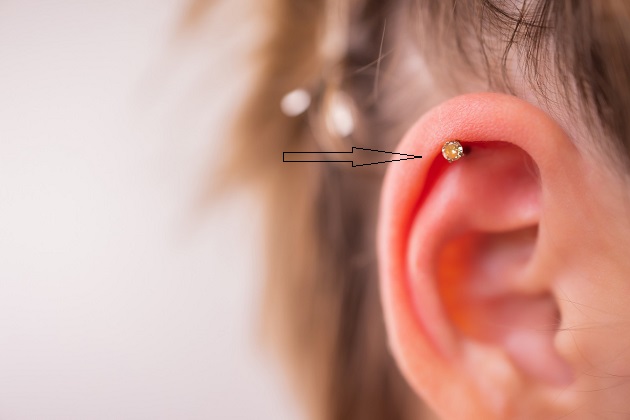Helix Ear Piercing
Helix ear piercing is a type of ear piercing that targets
the upper
cartilage of the ear.
This area, known as the helix, is the curved outer edge of the ear, making it an ideal canvas for adding stylish jewelry.
Helix piercings can be single, double, or even multiple, depending on your preferences and pain tolerance.
Getting Ready for the Piercing
Before going deep into the piercing process, it's important to
do some preparation to ensure a smooth experience:
Choose a Professional Piercer:
It's important to select a reputed and skilled professional
piercer.
Look for someone who operates in a clean and pure
environment, uses fixed equipment, and has positive reviews from previous
clients.
Picking the Right Jewelry:
For a fresh helix piercing, opt for hypoallergenic materials like surgical stainless steel, titanium, or niobium.
Avoid using cheap, low-quality metals that could cause irritation or allergic reactions.
Preparing Mentally:
Getting a piercing can be nerve-wracking, especially if it's
your first time.
Take a deep breath and remind yourself that the procedure
will be quick and worth the temporary discomfort.
The Piercing Procedure
On the day of your
piercing appointment, you might feel a mix of excitement and nervousness.
But don't worry, the process is generally straightforward
and follows these steps:
Cleaning the Area:
The piercer will clean your ear with an antiseptic solution to minimize the risk of infection.
Marking the Spot:
To ensure proper placement, the piercer will mark the exactspot where the needle will go through your helix. Take your time to review and
confirm the position before giving the green light.
The Piercing Itself:
Once you are ready, the piercer will use a hollow needle to
create a hole in your helix. You may feel a quick, sharp pinch, but the pain is
typically minimal.
Inserting the Jewelry:
Immediately after the hole is made, the piercer will insert
the jewelry of your choice into the freshly pierced helix.
Aftercare Instructions:
After the piercing, your piercer will provide you with
aftercare instructions to promote proper healing and minimize the risk of
complications.
Helix Piercing Aftercare
Taking care of your new helix piercing is crucial for preventing infections and ensuring a quick healing process.
Follow these simple steps:
Keep it Clean:
Twice a day, gently clean your piercing with saline solution or mild, fragrance-free soap. Avoid touching the area with dirty hands.
Hands-Off Policy:
Refrain from touching or twisting the jewelry unnecessarily. This can introduce bacteria and disrupt the healing process.
Avoid Swimming:
For the first few weeks, avoid swimming in pools, lakes, or
oceans, as these environments can harbor bacteria that
may lead to infections.
Watch for Irritation:
Keep an eye out for signs of irritation, such as redness,
swelling, or excessive pain. If you notice any of these, consult your piercer
or a medical professional promptly.
Be Patient:
Helix piercings can take several months to heal completely.
Be patient and resist changing your jewelry too soon.
Styling Your Helix Piercing
Once your helix piercing has fully healed, it's time to have fun with different jewelry options! There is a vast array of stylish and eye-catching earrings to choose from, including:
Studs:
Simple and elegant, studs are a classic choice that
complements any outfit.
Hoops:
Whether you go for a small and dainty hoop or a larger
statement piece, hoops add a touch of edginess to your look.
Captive Bead Rings (CBRs):
These circular earrings feature a removable bead that's held
in place by the
tension of the ring, creating a unique and modern style.
Ear Cuffs:
If you're not ready for a piercing just yet, ear cuffs are a
fantastic way to achieve a trendy look without commitment.
Potential Risks and Complications
While helix piercings are generally safe when done by a
professional, it's essential to be aware of potential risks, including:
Infections:
Poor aftercare or exposure to unclean
environments can lead to infections. Always follow your piercer's
instructions.
Allergic Reactions:
Using low-quality jewelry made of non-hypoallergenic
materials may cause allergic reactions in some individuals.
Keloids:
Some people may be prone to keloid formation, which is the
overgrowth of scar tissue around the piercing site.
When to Seek Medical Attention
If you experience any of the following symptoms, it's
crucial to seek
medical attention promptly:
Persistent Pain or Swelling:
Some initial pain is normal, but persistent pain and
swelling may indicate an issue.
Pus or Discharge:
The presence of pus or any unusual discharge can be a sign
of infection.
Fever:
A fever may indicate an infection that requires medical
attention.
Removing Helix Piercing
If you decide to remove your helix piercing, make sure the wound has fully healed before doing so.
Keep the area clean during the healing process and resist the urge to remove the jewelry prematurely.
Conclusion
Helix ear piercing is a fantastic way to express your
personality and add flair to your appearance.
By following proper aftercare and choosing the right
jewelry, you can enjoy your stylish helix piercing for years to come.
Always prioritize your safety and well-being by choosing a
professional piercer and diligently caring for your new piercing.
Embrace your uniqueness and rock your helix piercing with
confidence.

.webp)




.jpg)



0 Comments